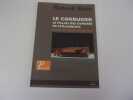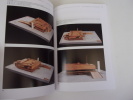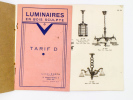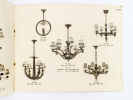-
Type
Any type (2)
Art print (7)
Book (31344)
Disk (1)
Drawings (7)
Engraving (9)
Magazine (125)
Old papers (1)
Photographs (14)
Posters (4)
-
Latest
Last 24h (11)
Last 3 days (38)
Last month (455)
Last week (41)
-
Language
Dutch (1)
English (52)
French (31417)
German (6)
Italian (18)
Portuguese (9)
Spanish (11)
-
Century
16th (15)
17th (56)
18th (215)
19th (1584)
20th (9552)
21st (1699)
-
Countries
Belgium (9489)
Brazil (7)
Canada (108)
China (1)
Côte d'Ivoire (66)
Denmark (218)
France (18513)
Germany (1)
Greece (1)
Italy (37)
Switzerland (3073)
-
Syndicate
ALAC (99)
CLAM (41)
CLAQ (94)
CNE (3)
ILAB (10920)
NVVA (1171)
SLACES (1171)
SLAM (8371)
SNCAO (9)
THE MUSEUM PROJECTS.
NY, Rizzoli, 1989, in-4 softcover, 160 pp, illustrations. Text in english. Signature on 1st page. Cover in good condition, inside very good.
Bethan Huws B.A.C.A. 2006
, Buchhandlung Walter K nig, 2006 Softcover, 168 pages, 26,5 x 20,5 cm. ISBN 9072251385.
Bethan Huws B.A.C.A. 2006 Bethan Huws (1961) is laureaat winnaar B.A.C.A. (Biennial Award for Contemporary Art) 2006, zij slaat een brug tussen haar Welsh afkomst en de conceptuele kunst. Haar werk omvat verschillende media, van tekeningen en objecten tot film en tekstwerken. De rode draad in haar werk is: vertalen. Vertalingen van de ene taal naar de andere, tussen culturen en van ervaringen naar concepten en omgekeerd.
"LA PROVENCE - COLLECTION ""LES PAYS D'ART""."
LIBRAIRIE HACHETTE. 1930. In-4. Broché. Etat d'usage, Coins frottés, Dos frotté, Intérieur acceptable. XV+122 pages. 172 gravures en noir et blanc dans texte. Frontispice en noir et blanc. Tampon sur la page de faux-titre.. . . . Classification Dewey : 720-Architecture
2 PHOTOS DISPONIBLES. Classification Dewey : 720-Architecture
Artists in Glass. Late twentieth century masters in glass.
London, Mitchell Beazley, 2001. 4°. 240 pp. With numerous pictures in colour. Orig. boards with dust jacket.
Decorative Art 1880 1980
, Phaidon Christies, 1986, 1986 Hardcover, 263 pages, ENG, 290 x 225 mm, in good order, with 700 illustrations including 175 in colour, . ISBN 9780714880259.
The decorative arts are arts or crafts whose object is the design and manufacture of objects that are both beautiful and functional. It includes most of the arts making objects for the interiors of buildings, and interior design, but not usually architecture. Ceramic art, metalwork, furniture, jewellery, fashion, various forms of the textile arts and glassware are major groupings. Applied arts largely overlaps with decorative arts, and the modern making of applied art is usually called design. The decorative arts are often categorized in distinction to the "fine arts", namely painting, drawing, photography, and large-scale sculpture, which generally produce objects solely for their aesthetic quality and capacity to stimulate the intellect.
L'esprit Art Déco.
Paris, Bookking International, 1991. 25 x 25, 288 pp., très nombreuses illustrations en couleurs et en N/B, broché, couverture à rabats, très bon état.
Traduction de Caroline Von Klitzing.
CATHEDRALE NOTRE-DAME DE STRASBOURG
Lescuyer, Lyon. 1980. In-8. Broché. Bon état, Couv. convenable, Dos satisfaisant, Intérieur frais. 76 pages. Illustré de nombreuses photos héliogravées en noir et blanc et de photos en couleur, dans et hors texte.. . . . Classification Dewey : 720-Architecture
Guide. Plans. Description. Classification Dewey : 720-Architecture
Cathédrale Notre-Dame de Strasbourg
Lescuyer. 1986. In-8. Broché. Bon état, Coins frottés, Dos satisfaisant, Intérieur frais. 79 pages. Nombreuses photos en couleurs, in et hors texte.. . . . Classification Dewey : 720-Architecture
Classification Dewey : 720-Architecture
Peter Paul Rubens and His Landscapes: Ideas on Nature and Art
be-, Brepols - Harvey Miller, 2014 Hardback, 300 pages., 38 b/w ill. 12 colour ill., 190 x 250 mm, Languages: English fine! . ISBN 9782503550381.
Painting landscapes was very much a private activity for Peter Paul Rubens. Whilst the majority of his other works were commissioned, the landscapes seem to have been painted for his own pleasure and delight and stayed in the artist?s possession until his death. Most of them were painted in the last decade of his life; a happy period, in which Rubens retired from public duties and spent most of his free time studying the antique and enjoying sojourns on his country estate, castle Het Steen. To grasp this profoundly personal character of Rubens?s landscapes, this book considers the artist?s highly complex method of pictorial invention to illuminate the perception, implementation, dissemination, and posthumous reception of views on nature and landscape as depicted in Rubens?s landscape art. By investigating contemporary notions on the changing perception of nature and landscape in late 16th and early 17th-century southern Netherlandish culture, Rubens?s position within this socio-cultural matrix will be established, thus shedding new light on the artist?s own perception of nature and landscape. The re-assessment of the influence of classical and contemporary ideas about nature and landscape, as well as Rubens?s personal sense of place, will illuminate important characteristics which further define Rubens?s ideas about nature implemented in his landscape art. Also, fresh light will be cast on the sudden promulgation and dissemination of Rubens?s apparently private views on nature and landscape through a novel examination of the print series of the Small and Large Landscapes, reproducing the artist?s landscapes. The final theme in this illuminating book considers the posthumous reception of Rubens?s ?painted ideas of landscape?. The book also contains an updated version of the catalogue raisonne of Rubens?s landscape art, supplemented by a record of the Small and Large Landscapes prints series
Rheinische Aussichtsstürme im 19. und 20. Jahrhundert
Aachen, 1985 397pp., with 61 bl/w ills., 30cm., Doctoral Dissertation (Von der Philosophischen Fakultät der Rheinisch-Westfälischen Technischen Hochschule Aachen zur Erlangung des akademischen Grades eines Doktors der Philosophie genehmigte Dissertation), softcover, stamp at verso of title page, text is clean and bright, good condition, weight: 1.4kg., S113040
LE CORBUSIER Le palais des congrès de Strasbourg. Nouveau programme, dernier projet
format moyen, couverture souple. 157 pages. Illustrations n/b et couleurs. Très bon état. Yne expédition par Mondial Relay pourra vous être proposée 2011 E. picard
Le Touquet Paris-Plage. La côte d'Opale des années Trente
Norma 1994 In-4 broché 28,5 cm sur 22,5. 166 pages. Très bon état d’occasion.
Très bon état d’occasion
Yves Klein. Stedelijk Museum Amsterdam 22.10 - 13.12 1965
Amsterdam, Stedelijk Museum, 1965 Softcover, 60 pagina's, 27.5 x 18.5 cm, Nederlandstalig/Fran ais. *prima staat.
Yves Klein.Stedelijk Museum Amsterdam 22.10 - 13.12 1965.
Lindstr m DIE FARBE IST EIN SCHREI
Rottach egem, LEU Gallery, 1988 softcover 300x210 mm, many illustrations in colour and b/w, text in DE/ FR / ENG. fine copy. tat bon
catalogue 1988
Der Kreuzgang aus St.-Guilhem-le-Desert in The Cloisters in New York
Berlin, Dr. Köster 1994 Livre en allemand. In-8 broché. 364 pages. Très bon état d’occasion.
Très bon état d’occasion
INTERIORES MINIMALISTAS. MINIMALIST INTERIORS.
KLICZKOWSKI Publisher, ASPPAN, CP67 ; 1998, in-4 hardcover, dustjacket , 207 pp, illustrations. In english & spanish. A small tear on titlepage, otherwise very good.
LOFTS MINIMALISTAS. MINIMALIST LOFTS.
KLICZKOWSKI Publisher, ASPPAN, CP67 ; 2001, in-4 hardcover, dustjacket , 215 pp, illustrations. In english & spanish. Very Good Condition.
Josef Hehl 1885 - 1953.
Xanten, Stadt Xanten, , 2003 Softcover, 143 S. mit einem Frontispiz und zahlreichen Abbildungen very richly illustrated with coloured illustrations.
niederrheinischen topfers und plastikers / Ceramique / keramiek.
David Teniers de Jonge: Schilderijen. Tekeningen
, Koninklijk Museum voor Schone Kunste, 1991 softcover, originele geillustreerde uitgeversomslag in kleur, 24,5x31cm, 335pp, geillustreerd in kleur en z/w. ISBN 9789053490181.
Boek dat verscheen bij gelegenheid van een tentoonstelling in het Koninklijk Museum voor Schone Kunsten in Antwerpen in 1991 over David Teniers, toen 300 jaar eerder overleden. Teniers (1610-1690) was een van de grootste schilder van zijn tijd. Alle thema's van de genreschilderkunst komen bij hem aan bod: taferelen met boeren en burgers, galante en soldateske sc nes met veelal moraliserende inslag, religieuze voorstelllingen en portretten.
Martin Gropius und die Berliner Schule
Berlin, 1971 215pp., 21cm., softcover, text in German, Doctoral dissertation (Von der Fakultät für Architektur der Technischen Universität Berlin zu Verleihung der akademischen Würde Doktor-Ingenieur genehmigte Dissertation), stamp at verso of title page, text is clean and bright, good condition, S109431
F. Pauli. Radierungen. Einleitung und Text von Dr. Paul Schaffner.
Erlenbach-Zürich, Eugen Rentsch, 1926. 4°. 86 Textseiten. 48 s/w Tafeln und 13 Zeichnungne im Text. Orig. LeinenMit Rückenprägung und Deckelzeichnung.
Nr. 64 von 130 Exemplaren der Vorzugsasugabe für die Mitglieder der Schweizerischen Graphischen Gesellschaft. Mit einer signierten Originalradierung.
Luminaires en bois sculpté K. L. ( KARCH, Lucien ) : Supplément catalogue 1933 + Tarif D.
2 fasc. dont 1 in-4 br. et 1 in-12 br., ill. noir et blanc, Lucien Karch, 8 impasse Druinot, Paris, 1933, planches 24 à 36 (catalogue) et 8 pp. (tarif)
Bon état. Peu courant.
Das Zisterzienserkloster Eldena in Pommern nach den im Jahre 1926/27 vorgenommen Ausgrabungen
s.l., 1928 91pp., with 69 illustrations in text + 1 folding plate, 25cm., modern hardcover, text in German, Doctoral Dissertaztion (Von der technischen Hochschule Hannover zur Erlangung der Würde eines Doktor-Ingenieurs genehmigte Dissertation), stamp at verso of title page, R110232
Bouwkunst in de stad en op het land. Tweede vermeerderde druk met 424 afbeeldingen.
Rotterdam, W.L. & J.Brusse 1918, 255x190mm, IX- 190pages, reliure d’éditeur. Höhere Kappe beschädigt - Coiffe supérieure abimée.
Pour un paiement via PayPal, veuillez nous en faire la demande et nous vous enverrons une facture PayPal
Le paradis terestre de Picassiette.
Encre 1979 Encre, Coll. les Banlieues de l'Art, 1979, 102 p., cartonnage éditeur, dos insolé, coiffes et coin un peu frottés, bon état pour le reste et intérieur bien propre.
Merci de nous contacter à l'avance si vous souhaitez consulter une référence au sein de notre librairie.
 Write to the booksellers
Write to the booksellers










